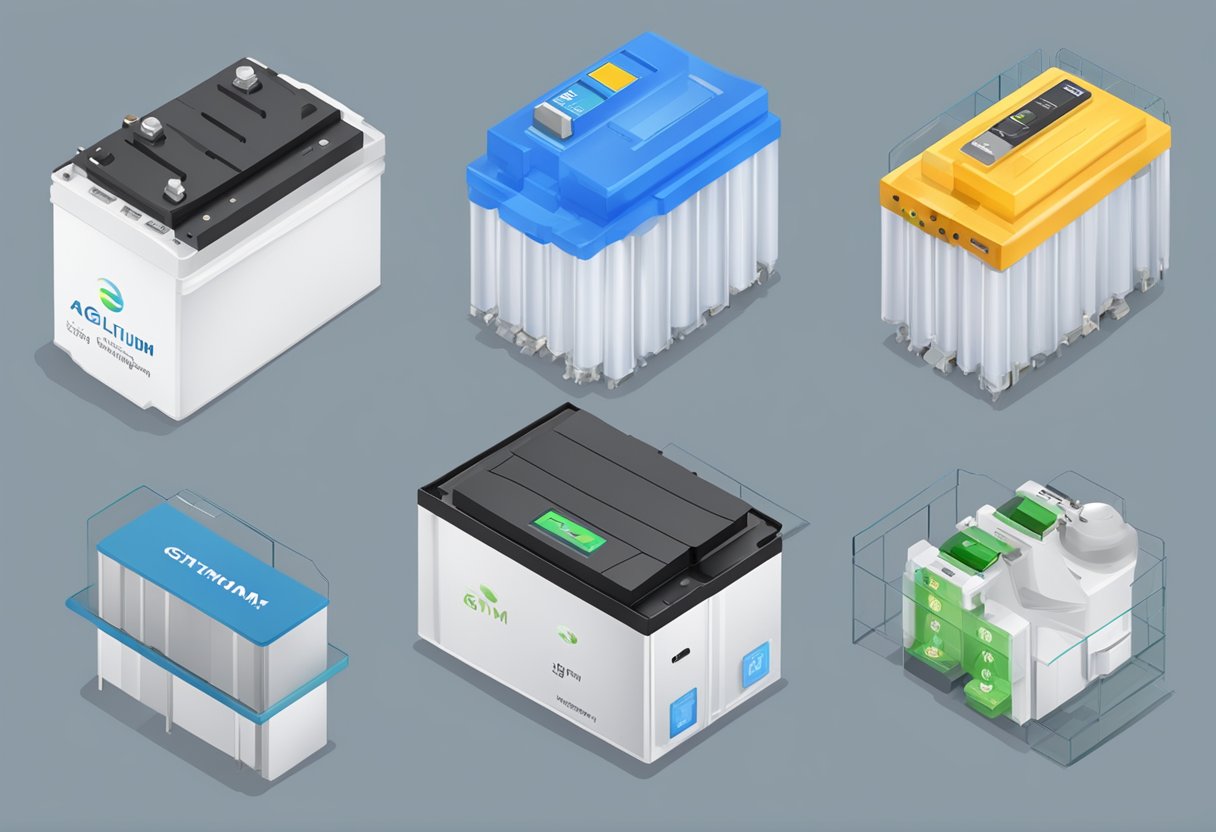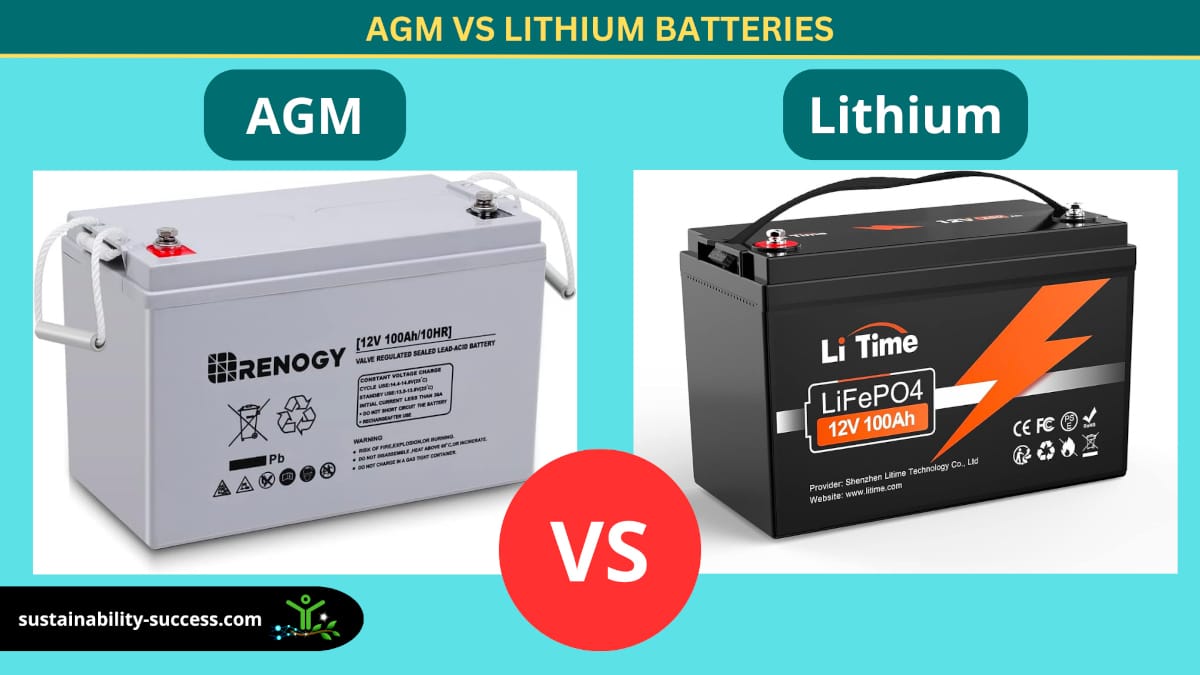In the world of rechargeable batteries, two leading technologies are widely recognized for their unique benefits and applications: Absorbent Glass Mat (AGM) and Lithium-based batteries. AGM vs lithium batteries, which is better?
AGM batteries have been a reliable power source for years, known for their durability and maintenance-free design. They are frequently used in vehicles, uninterruptible power supplies (UPS), and various other devices where battery failure is not an option.
Conversely, lithium batteries are celebrated for their high energy density, lightweight properties, and longer lifespans, which make them especially suited for portable electronics, electric vehicles, and renewable energy storage systems.
Although AGM batteries generally entail lower upfront costs than their lithium counterparts, the potential long-term savings and performance benefits offered by lithium technology are considerable for many users.
Key Takeaways
- AGM and lithium batteries possess distinctive characteristics suited for different uses.
- Lithium batteries offer a higher energy density and longer lifespan compared to AGM.
- The choice between AGM and lithium batteries involves considering cost, performance, and application suitability.
Fundamentals of Battery Technology

In the realm of portable power, the continuous evolution of battery technology has led to the development of two major types: AGM (Absorbent Glass Mat) and Lithium batteries, each with distinctive qualities and applications.
Lead-Acid Batteries and AGM Technology
Lead-acid batteries have been the cornerstone of energy storage solutions for over a century.
Within this category, the AGM battery represents a significant advancement. It uses an absorbent glass mat to wick the electrolyte solution between the battery plates. This design allows for lower internal resistance, greater electrical reliability, and the ability to withstand low temperatures.
AGM technology offers a moderate energy density and an enhanced lifespan compared to traditional lead-acid batteries.
Lithium Batteries and LiFePO4
Lithium batteries, and specifically Lithium Iron Phosphate (LiFePO4), are a newer generation that has been gaining traction.
These batteries boast a high energy density, meaning they can store more energy per unit of weight than their AGM counterparts. LiFePO4 batteries are renowned for their stability and long lifespan, with performance unaffected by a deep discharge.
Lithium-ion batteries, a subgroup of lithium batteries, are prevalent in portable electronics and electric vehicles.
Performance Metrics
When evaluating the performance of AGM and lithium batteries, one should consider several key metrics including capacity, efficiency, cycle life, depth of discharge, charging time, and required maintenance.
Energy density
When comparing energy densities between battery types, lithium batteries typically come out on top. They have the capability to offer a significantly higher energy density compared to AGM batteries. This translates into longer runtimes for devices per charge and often a lighter weight, making lithium batteries particularly well-suited for mobile and high-demand applications.
Capacity and Efficiency
Absorbent Glass Mat (AGM) batteries are known for their reliability and stable power output. They typically have a lower energy density, meaning that they store less energy per unit of weight compared to lithium batteries.
Conversely, lithium batteries excel in energy density, providing more power for less weight, making them highly efficient. This higher energy density relates directly to their increased efficiency, as they are capable of delivering more energy without the bulk seen in traditional AGM batteries.
Cycle Life and Depth of Discharge
Cycle life is considered a strong suit for lithium batteries. They can withstand a greater number of charge and discharge cycles before their capacity drops below 80% of their original capacity. AGM batteries, while sturdy and resilient, often have a shorter cycle life in comparison.
Depth of Discharge (DoD) reflects the percentage of the battery that has been discharged relative to the overall capacity. Lithium-ion technologies can frequently handle a deeper DoD without significant impacts on their cycle life.
Charging Time and Maintenance
When it comes to charging time, lithium batteries are generally quicker to charge than AGM batteries. This efficiency is advantageous for applications that require quick energy replenishment.
Both AGM and lithium battery systems are predominantly maintenance-free.
Applications and Compatibility
Selecting the right battery technology hinges on an understanding of specific applications and compatibility requirements. Different battery types excel in distinct scenarios based on factors such as energy density, weight, and discharge patterns.
Renewable Energy Systems
In renewable energy systems, especially those with solar panels, AGM batteries have been traditionally used as house batteries due to their reliability and affordability.
However, lithium batteries are increasingly preferred in scenarios where higher energy density and a longer lifespan are crucial. For example, the modern solar generators for off-grid living are all based on lithium.
For instance, here are the best batteries for RV solar systems. Lithium options provide sustained power output and require less space, making them suitable for compact solar setups.
Mobility and Transportation
For mobility and transportation, the choice between AGM and lithium batteries largely depends on the specific use case. Cars and vans typically come equipped with AGM batteries given their robust start-stop technology.
On the other hand, electric vehicles and golf carts benefit from the lighter weight and longer range provided by lithium batteries. They are ideal where quick acceleration and efficient energy use are key.
Recreational Vehicles and Marine Use
In the context of recreational vehicles (RVs), motorhomes, and marine applications like boats with trolling motors, choosing the right battery type is critical. AGM batteries are often used as RV batteries and for marine applications due to their deep discharge capabilities and decreased maintenance.
But for those seeking extended off-grid use or who have significant power demands, lithium batteries for RV offer a superior power-to-weight ratio and longer life cycles, which make them an optimal choice for frequent travelers or for use in marine environments.
Economic Considerations
When examining the economic implications of AGM versus lithium batteries, one should consider the initial costs, potential long-term savings, and warranty aspects that may affect overall value.
Initial Cost Analysis
AGM (Absorbed Glass Mat) batteries usually have a lower initial cost compared to lithium batteries. This is because the materials and manufacturing processes involved in AGM batteries are currently less expensive.
So although AGM batteries may appear economical in the short term, it is crucial to also assess their performance and lifespan when determining their financial viability.
Long-Term Return on Investment
In the long run, lithium batteries could offer a better return on investment (ROI) due to their superior energy density and longevity. These batteries are known to have a longer lifespan, which means they need to be replaced less frequently.
Additionally, lithium batteries maintain a higher efficiency over their life cycle, leading to potential cost savings in energy usage and less frequent need for replacement.
Warranty and Longevity Considerations
The warranty period offered with a battery can reflect its expected longevity and the manufacturer’s confidence in its product. Typically, lithium batteries come with longer warranties, suggesting that they are designed to last longer.
While AGM batteries can be more resistant to temperature extremes, lithium batteries are often warranted to sustain a higher number of charge cycles, possibly translating into greater utility over time.
The decision between AGM and lithium batteries should be informed by an analysis of up-front costs and anticipated long-term benefits, along with warranty coverage, which collectively influence the total cost of ownership.
Safety and Environmental Impact

When comparing AGM and lithium-ion batteries, it is crucial to assess their safety features and environmental concerns. Each type has distinct attributes and potential impacts that are important for users to consider.
Safety Features
Absorbent Glass Mat (AGM) batteries, a type of lead-acid battery, are regarded for their safety due to the immobilization of the electrolyte in a fibrous glass mat, reducing the risk of leaks and spills.
They can withstand rough conditions and vibrations without significant performance loss. Moreover, AGM batteries generally do not require a complex battery management system owing to their simpler chemistry.
In contrast, lithium-ion batteries, including LiFePO4 (lithium iron phosphate), are equipped with advanced battery management systems to monitor temperature, voltage, and current, preventing overheating and overcharging which can pose safety risks.
LiFePO4 batteries are considered safer than other lithium-ion chemistries due to their thermal and chemical stability.
Environmental Concerns
The production and disposal of both AGM and lithium-ion batteries raise environmental sustainability concerns.
AGM batteries, as lead-acid batteries, involve lead, a toxic substance that requires careful handling and recycling to mitigate its environmental impact. However, the recycling infrastructure for lead-acid batteries is well-established, making them one of the most recycled products.
Lithium-ion batteries, although not containing lead, pose other environmental impacts. The extraction of lithium and other associated minerals can lead to soil and water contamination, as highlighted by a report on the Environmental Impacts of Lithium-Ion Batteries – UL.
Disposal remains a concern too since lithium-ion batteries are classified as electronic waste and need to be processed to prevent harmful chemicals from affecting the environment. The acquisition of raw materials for lithium-ion batteries often involves intensive mining activities that can disrupt ecosystems.
Both battery types play a role in renewable energy systems and battery storage solutions, contributing to the reduction of carbon footprints when used efficiently. It is the responsibility of industry and consumers alike to weigh these safety and environmental factors when choosing a battery solution.


